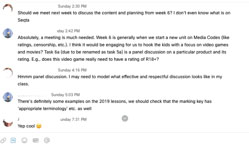The Post Pandemic Professional Learning Community

After the tumultuous few weeks, Western Australia can proudly declare its range of measures and restrictions shielded the state from a catastrophic COVID-19 scenario. We now incredibly find ourselves in the enviable situation where schools can proclaim, ‘we are open for business’.
In this essay, I share my reflections as English Head of Learning Area at Joseph Banks Secondary College and explore how the crisis may reshape how teachers work together. Instead of a collective capitulation, the pandemic stimulated ingenuity and forged true collaboration within teaching teams. I unpack how we harnessed the power of WebEx Teams, OneNote, collaborative lesson planning and evaluate how our impact through data will play a greater role in our post pandemic school.
What is a Professional Learning Community?
The OECD’s Teaching and Learning International Survey of 107,000 teachers across 34 countries in 2013 found that teachers who work together on at least a weekly basis had more belief in their capacity to execute the skills needed to improve student learning than those who worked together less frequently. It also had the added benefit that they were more satisfied with their jobs (OECD, 2014). Promoting a professional learning community through the collaborative work of professional learning teams not only contributes to collective efficacy in the school, but also the perceived efficacy of individual staff.
A Professional Learning Community (PLC) represents a collective effort to enhance student learning, promotes and sustains the learning of all professionals in the school, builds knowledge through inquiry; and analyses and uses data for reflection and improvement (Bolan, R, 2005). Essentially PLCs underpin their practice through true collaboration which involves a ‘systematic process in which we work together, interdependently, to analyse and impact professional practice in order to improve our individual and collective results’ (DuFour, R., DuFour, R., & Eacker, R, undated).
Collaboration involves a mindset where school staff can and should learn from one another in a structured environment. The collaborative team continually processes reflection, research, debate, discussion and problem solving. A collaborative team may describe a PLC as ‘our daily work, not an add on’.
March 2020: A crisis and a catalyst
The Government COVID response directives instantly stunned school operations and teaching structures. Schools reorganised and restricted access to the children of essential workers. Many school staff with compromised immune systems, aged over 60 or Indigenous colleagues over 50, immediately worked from home. Conjecture was ubiquitous and media and union messaging stoked the fear and anxiety fires. School leaders acted as the conduit from Central Office as the fluid situation often meant communiques changed within a day.
By and large, school staff remained resilient and focused on the goal of continuity of student learning. Hyper adaption was the only game in town.
The tools where there, but how could they be used effectively? The ability was there, but how could it be harnessed broadly? Within the crisis, staff instinctively knew what to do and worked closer than ever before.
The aftermath
In Week 5, Term 2 and at the time of writing, Western Australia has 10 zero active COVID-19 cases and many Department of Education Schools record attendance data on a par with pre-crisis data. As our school begins to look and feel like how things were before, from my vantage point, there were tangible differences in the way the English team operated. The nineteen strong English team at JBSC understands the importance of reducing the variability between classes. JBSC is a PLC school so subject teachers are positioned around the school in learning communities. The staffing structure promotes deeper discussion about students and learning as your office colleagues teach the same students you teach. Effective lines of communication are therefore crucial in our system.
The team understands that if lessons are collaboratively planned, the team can produce a higher number of quality lessons. Since 2016, our team meets frequently to plan lessons for students and parents to access on the SEQTA learning management system. Teachers possess discretion over lesson delivery; however, if four teachers have contributed to a curriculum aligned and differentiated series of lessons, then when all classes employ a resource, every Year 7 child for instance, accesses the best learning material. This reduce instructional variability.
Interestingly, the collaborative model can creak or slip at times when workload spikes. We quickly realised we required additional tools to strengthen communication when we could not meet face to face.
As the number of coronavirus cases spiked in late March, the JBSC ICT staff introduced Webex Teams, a tool for teams to communicate in professional chatroom context for staff to keep in touch as they worked from home. Our early career teachers immediately hooked into the medium, even using GIFS to signal mood or feelings.
At the time of writing and at most times of the working day, Webex is still alive and used powerfully. English staff communicate intensely about the literacy of a graphic organiser, the rigour of a rubric or who would like a coffee from Maccas. We still use email; however, Webex teams present a professional informality that streamlines communication and builds trust.
 Figure 1
Figure 1
Microsoft OneNote offered another way to make our teams connect. OneNote is a digital notebook for free-form information gathering and multi-user collaboration. Notes can be shared with other OneNote users via link or adding them as collaborators to the notebook. The tool was widely adopted for weeks of anticipated online learning. Fast forward to June, and the tool continues to be used by teachers. Three classes for example, recently collaborated on OneNote documents to enable students to access a wider range of peer thinking.
Accelerating student learning in a post pandemic world
The risk taking and agile decision making executed in the final weeks of Term One has not been in vain. With the collective efficacy high, we must ensure we measure and evaluate the impact of our actions. At the core of a high-performance culture is a process about how teachers will be involved in evaluating their own teaching and the impact it is having on their students. Kane (quoted in Bill & Melinda Gates Foundation, 2013) notes that, ‘If we want students to learn more, teachers must become students of their own teaching’. Highly Accomplished teachers work with colleagues to use data from student assessments to evaluate learning and teaching, identify interventions and modify teaching practice (AITSL Standards 2017). The Joseph Banks Secondary College English Learning Area just commenced the five-week data review process to capture timely information about student progress. As HoLA, I share cohort data every five weeks to compare our grade distribution to Like Schools and promote discussion about the faces behind the data. In addition, four teachers participate in the Evaluating My Impact Project through recording their class data on a single ‘anywhere’ Microsoft OneDrive excel data document to examine their classes’ progress with colleagues or to engage with their HoLA in coaching conversations to explore how we can accelerate student learning.
 Figure 2
Figure 2
The integral driver of leadership
The integral driver in how fast well we can push away from the crisis is how we strengthen and distribute leadership over the coming months. I witnessed the best type of leadership over the last couple of months that represented personal integrity, commitment and honesty to develop stronger and more trusting relationships with teachers. School leaders working in a culture of trust empower teachers and draw out the best in them (Brewster & Railsback, 2003). My experience at Clarkson Community High School between 2018 and 2020 taught me much about the ‘invitational stance’ to education and in particularly the five domains that exist in practically every environment and contribute to the success or failure of each individual. This involves the people, places, policies, programs and processes. There is now a strong case for the five "Ps" to occupy a more prominent place in our school leaders’ thinking, as they forge a new reality where teachers work together innovatively to enhance student learning in a post pandemic world.
References
Brewster, C. & Railsback, J. (2003). Building trusting relationships for school improvement: Implications for principals and teachers. Oregon, USA: Northwest Regional Educational Laboratory.
Bolan, R., McMahon, A., Stoll, L., Thomas, S., Wallace, M., Hawkey, K., & Greenwood, A. (2005). Creating and sustaining effective professional learning communities, DfES Research Report 637. London: Universities of Bristol and Bath and the London Institute of Education
DuFour, R., DuFour, R., & Eacker, R. (undated). Professional Learning Communities (PLC): Where do we begin [PowerPoint slides]. PowerPoint presentation accessed from http://www.powershow.com/view3/438cf3-Y2FlN/Professional_Learning_Communities_PLC_ powerpoint_ppt_presentation
OECD. (2014). A teachers’ guide to TALIS 2013: Teaching and Learning International Survey, TALIS. Paris: OECD Publishing.
Bill & Melinda Gates Foundation. (2013, January 8). Measures of effective teaching project releases final research report. Bill and Melinda Gates Foundation. Retrieved from: https://www.gatesfoundation.org/Media-Center/Press-Releases/2013/01/Measures-of-Effective-Teaching- Project-Releases-Final-Research-Report
Thomas Jones is Head of English Learning Area and Level 3 Classroom Teacher at Joseph Banks Secondary College in Banksia Grove, Perth and former Head of Learning Area at Clarkson Community High School. He takes a keen interest in rigorous student-centred curriculum, the role of data in producing equitable student outcomes and building high trust cultures. He has strengthened his leadership acumen through completing the Masters of School Leadership degree at the University of Western Australia and the Growth Coaching International (CGI) Accredited Coach qualification. Thomas was a member of the Department of Education’s 2019 Leadership Strategy Advisory Group to review the implementation of the WA Public School Leadership Strategy 2018 – 2021.
Image by gnarburger just a try available under flicr cc attribution license